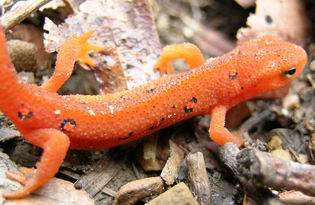May 7, 2006
Salamander and Newt Larvae Care
Once the eggs are laid, place them in a separate tank from the adults. Depending on how many eggs you have will determine the size of the tank you will need. You definately need a good filter in the tank. Also, you will have to make partial water cleanings. You do this by taking some old water out, then putting clean water in. Make sure the clean water is the same temperature as the old water. (more…)
January 7, 2006
Japanese Firebelly Newt. Cynops pyrrhogaster

Scientific Name: Cynops pyrrhogaster
Total Length: 3.5 – 5 inches
Range: Japanese islands of Honshu, Shikoku, and Kyusho
(more…)
September 4, 2005
Salamander/Newt Egg-Laying and Metamorphosis
Most salamander/newt species’ eggs hatch as aquatic, gilled larvae that need a period of time in the water so they can metomorphose into adults. Unlike the tadpoles of frogs, the salamander/newt larvae have feathery, external gills on both sides of the head. Also, the front legs develop before the back ones (opposite in frogs). (more…)

